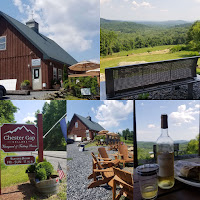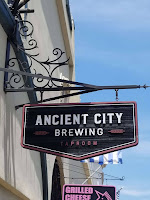 Key West was also home to America's first overseas air transport flight when on October 19, 1927, a Pan American World Airways Fairchild FC-2 floatplane delivered mail from Key West to Havana. From that date until its "collapse" on December 4, 1991, Pan Am was the principal and largest international air carrier in the United States. In Key West tickets were sold out of their building on 301 Whitehead Street and since the company's closure has operated as a brewpub first under the ownership of actress Kelly McGillis (Kelly's Caribbean Bar Grill & Brewery) and now as First Flight Island Restaurant & Brewery. This brewery has a core lineup of beers that cater to the tourism market - an Amber, IPA, and Wheat ale; but they also produce a limited release series where the best action occurs. The Czech Engine Pilsner is spot on and their Beach Day IPA is a juicy blend of tropical fruits. For dessert hope the Midnight Landing Honey Porter or Nuts & Bolts Chocolate Peanut Butter Ale are on tap.
Key West was also home to America's first overseas air transport flight when on October 19, 1927, a Pan American World Airways Fairchild FC-2 floatplane delivered mail from Key West to Havana. From that date until its "collapse" on December 4, 1991, Pan Am was the principal and largest international air carrier in the United States. In Key West tickets were sold out of their building on 301 Whitehead Street and since the company's closure has operated as a brewpub first under the ownership of actress Kelly McGillis (Kelly's Caribbean Bar Grill & Brewery) and now as First Flight Island Restaurant & Brewery. This brewery has a core lineup of beers that cater to the tourism market - an Amber, IPA, and Wheat ale; but they also produce a limited release series where the best action occurs. The Czech Engine Pilsner is spot on and their Beach Day IPA is a juicy blend of tropical fruits. For dessert hope the Midnight Landing Honey Porter or Nuts & Bolts Chocolate Peanut Butter Ale are on tap.As its name implies, The Waterfront Brewery overlooks the Key West Historic Seaport and Bight and operates as a brewery, restaurant, and a licensed wholesaler of Florida Keys finfish and shellfish. The brewery offers a strong portfolio ranging from an Island Life Lager to the TruMan Double IPA. Both of these are well made, the first a refreshing quaffer, the second a rather smooth and complex offering. However, our two favorites were the Key Lime Gose and Lazy Way IPA - both provide tropical flavors with the kettle-soured Gose tart and refreshing while the Lazy Way is a juicy, juicy IPA.

 Being so close to the Caribbean Key West is practically synonymous with rum and the first place to imbibe is the Key West First Legal Rum Distillery -- opened in 2012 by Chef Paul Menta and Tony Mantia. The distillery is housed in a building built in 1900 that was the original location of Jack's Saloon and once a Coca-Cola bottling facility. Today the building houses distilling equipment that cranks out several styles of rum from a clean white to flavored to a high octane 105 Simonton Rum. The rums are produced by fermenting sugarcane juice which is then generally distilled six times. If the rum is aged they use salt-cured barrels and when flavored they utilize locally-sourced food flavors. Our overall favorite was the Aged Key West Raw and Unfiltered Rum ($63) aged in new American oak barrels. The distillery never uses previously used barrels and instead purchased #3 charred barrels which they fill with fresh seawater. Overnight the barrel expands and in the morning the water is drained and the barrels cure in the sun. The salt residual opens the pores of the wood allowing the rum to soak up more of the wood nuances such as fig, plum, vanilla, and pepper. This raw and unfiltered rum definitely has these characteristics as well as a bit of funk - that makes it truly unique. This make is compatible with a Dark and Stormy and even more compatible by adding grapefruit juice to that cocktail plus a little lime. The other rum we purchased was the Cuban Coffee Rum ($35) where dark roasted coffee beans are aged in rum barrels to create a coffee extract. Then Demerara sugar is toasted and added to the coffee in order to create a "true Key West Colada Cafe". The rum is savory and we've used as a morning quick start or an evening dessert.
Being so close to the Caribbean Key West is practically synonymous with rum and the first place to imbibe is the Key West First Legal Rum Distillery -- opened in 2012 by Chef Paul Menta and Tony Mantia. The distillery is housed in a building built in 1900 that was the original location of Jack's Saloon and once a Coca-Cola bottling facility. Today the building houses distilling equipment that cranks out several styles of rum from a clean white to flavored to a high octane 105 Simonton Rum. The rums are produced by fermenting sugarcane juice which is then generally distilled six times. If the rum is aged they use salt-cured barrels and when flavored they utilize locally-sourced food flavors. Our overall favorite was the Aged Key West Raw and Unfiltered Rum ($63) aged in new American oak barrels. The distillery never uses previously used barrels and instead purchased #3 charred barrels which they fill with fresh seawater. Overnight the barrel expands and in the morning the water is drained and the barrels cure in the sun. The salt residual opens the pores of the wood allowing the rum to soak up more of the wood nuances such as fig, plum, vanilla, and pepper. This raw and unfiltered rum definitely has these characteristics as well as a bit of funk - that makes it truly unique. This make is compatible with a Dark and Stormy and even more compatible by adding grapefruit juice to that cocktail plus a little lime. The other rum we purchased was the Cuban Coffee Rum ($35) where dark roasted coffee beans are aged in rum barrels to create a coffee extract. Then Demerara sugar is toasted and added to the coffee in order to create a "true Key West Colada Cafe". The rum is savory and we've used as a morning quick start or an evening dessert. The island also features two other distilleries that we were unable to visit. Papa's Pilar Rum is also located on Simonton Street and concentrates on one iconic rum brand named after the famous author and his fishing boat. Key West Distilling just moved to the Stock Island Marina Village and goes beyond rum by also producing whiskey, vodka, and gin -- the latter two using Florida sugar cane. Next trip to the Keys. Cheers.
The island also features two other distilleries that we were unable to visit. Papa's Pilar Rum is also located on Simonton Street and concentrates on one iconic rum brand named after the famous author and his fishing boat. Key West Distilling just moved to the Stock Island Marina Village and goes beyond rum by also producing whiskey, vodka, and gin -- the latter two using Florida sugar cane. Next trip to the Keys. Cheers.



















































